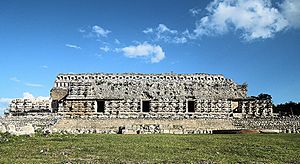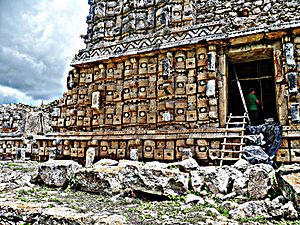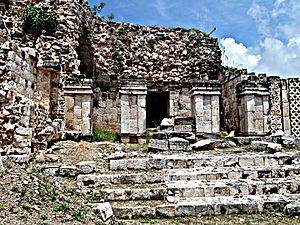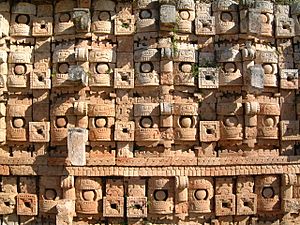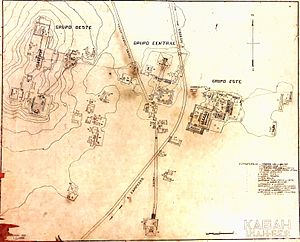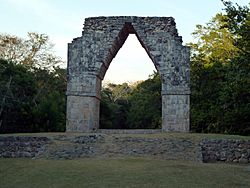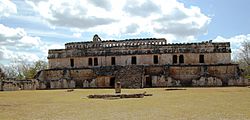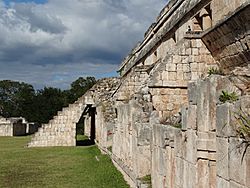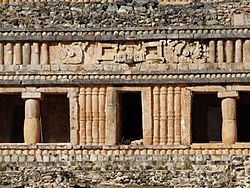Kabah (Maya site) facts for kids
Kabah (also spelled Kabaah or Kabáh) is an ancient Maya city. It is located in the Puuc region of western Yucatan, which is in Mexico. Kabah is south of the famous Maya city of Uxmal.
These two cities were connected by a long, raised road called a causeway. This road was 18 kilometres (11 miles) long and 5 metres (16 feet) wide. It had large arches at each end. Kabah is the second largest ancient city in the Puuc region, after Uxmal.
You can find Kabah on Fed. 261. It is about 140 kilometres (87 miles) south of Mérida, Yucatán. Many people visit Kabah as a tourism destination. Some parts of the ruins are still covered by forest. Since 2003, archaeologists have been working to clear and restore more buildings.
Kabah became a Yucatán state park in 1993. This helps protect the ancient city.
Contents
History of Kabah
The name Kabah likely means "strong hand" in the ancient Maya language. This name was used long before Europeans arrived. It is even mentioned in an old Maya book called the Book of Chilam Balam of Chumayel.
People lived in this area starting around 250 BCE. Most of the buildings you see today were built between the 7th and 11th centuries CE. One carving found at Kabah suggests the city was at its peak around 879 CE. Another carving shows a date of 987 CE, which is one of the latest dates carved in the Classic Maya style.
Amazing Architecture
The most famous building at Kabah is the "Palace of the Masks." It is also known as the Codz Poop, which means "Rolled Matting." This is because of the unique pattern of its stone mosaics. The front of this palace is covered with hundreds of stone masks of the long-nosed rain god Chaac. It's very unusual in Maya art to see the same design repeated so many times.
You can find masks of the rain god on other buildings throughout Kabah too. Archaeologists have even found copal incense inside some of the stone noses of these rain god masks. The Maya people in this area focused a lot on Chaac. This is because the Puuc region is very dry. There are no natural underground water sources called cenotes here. So, the Maya people depended only on rain for their water.
Kabah also has other palaces, low stone buildings, and pyramid temples. Most of these buildings are in the Puuc Maya style. However, some also show elements from the Chenes style. Many carved panels, lintels (door frames), and doorjambs were found here. Most of these have been moved to museums. These carvings often show the city's rulers and scenes of battles.
The first detailed description of Kabah was published in 1843 by John Lloyd Stephens and Frederick Catherwood.
Main Building Groups
Kabah is made up of several groups of buildings. Each group has its own special features.
Northwest Group
This group includes structures 1A1 and 1A2. It sits on top of a ridge at the western edge of the city. From here, you can look out over the main part of Kabah to the east.
West Group
The West Group has structures 1A7 and 1A8. It also includes the Court of Structures, which has buildings 2A1, 2A2, and 2A3.
East or Palace Group
This is the largest and most important group of buildings at Kabah. It includes structures 2B1-3, 2C1, 4, 5, 2C2, 2C3, 2C6, and 2C7. These buildings are also the best preserved. They face west, looking over the central part of the city.
Other Structures and Sculptures
Beyond the main areas, there are many other groups of buildings. These include structures 1A3-6, 1B2, 1B3, 1C1-3, and 3B1.
Kabah also has various sculptures. Some of these are pieces of statues that might show people, gods, or rulers. One important sculpture, M1, looks like a clenched hand. This sculpture is often thought to be why the site was named "Kabah." The site also has altars and other small stone buildings. Kabah has more large, impressive structures than any other site in the Puuc region.
Archaeological Research
In 1955, researchers Karl Ruppert and A. Ledyard Smith studied Kabah. They wanted to compare the types of houses found here with those in other Maya cities. They found that most houses at Kabah had either one room with a doorway or several adjoining rooms, each with its own doorway. Many houses used well-cut stones that had been used before in other buildings.
Scientists have also studied tiny living things called microbial biofilms at Kabah. These biofilms can cause stone buildings to break down over time. Different types of these tiny organisms, like Xenococcus, Gloeocapsa, and Synechocystis, were found on the stone walls.
Images for kids
See also
 In Spanish: Kabah (sitio arqueológico) para niños
In Spanish: Kabah (sitio arqueológico) para niños


